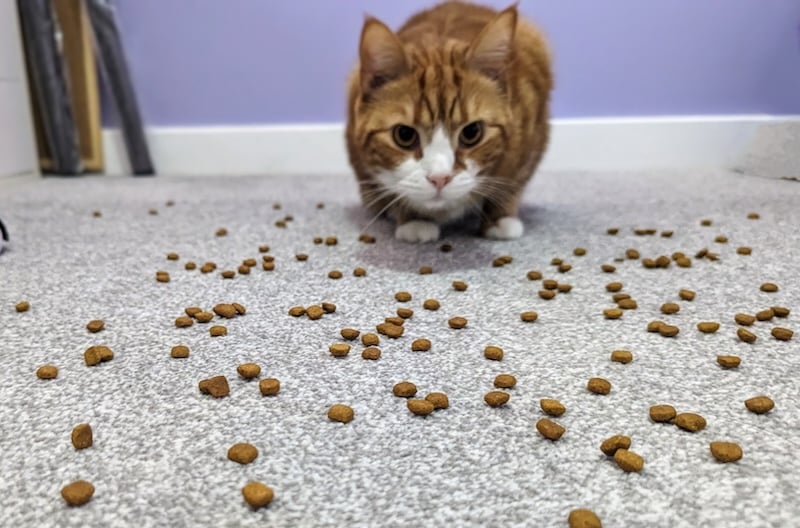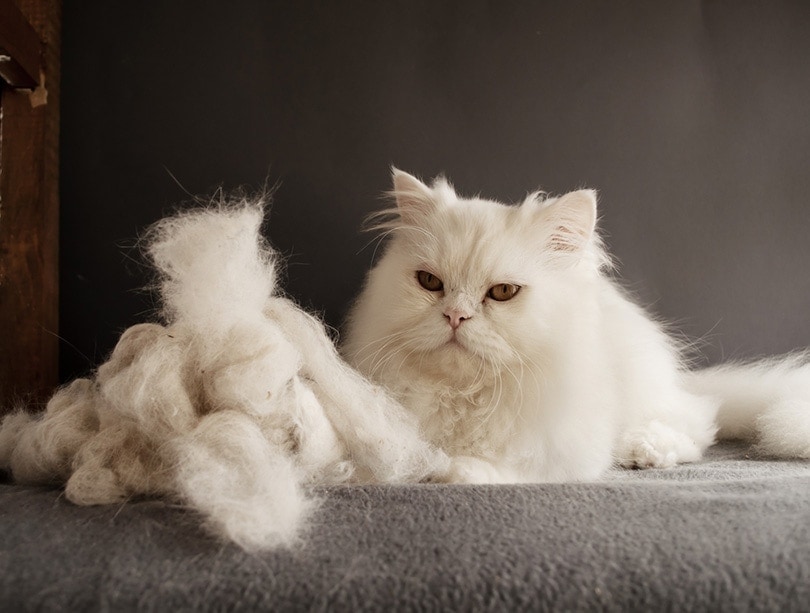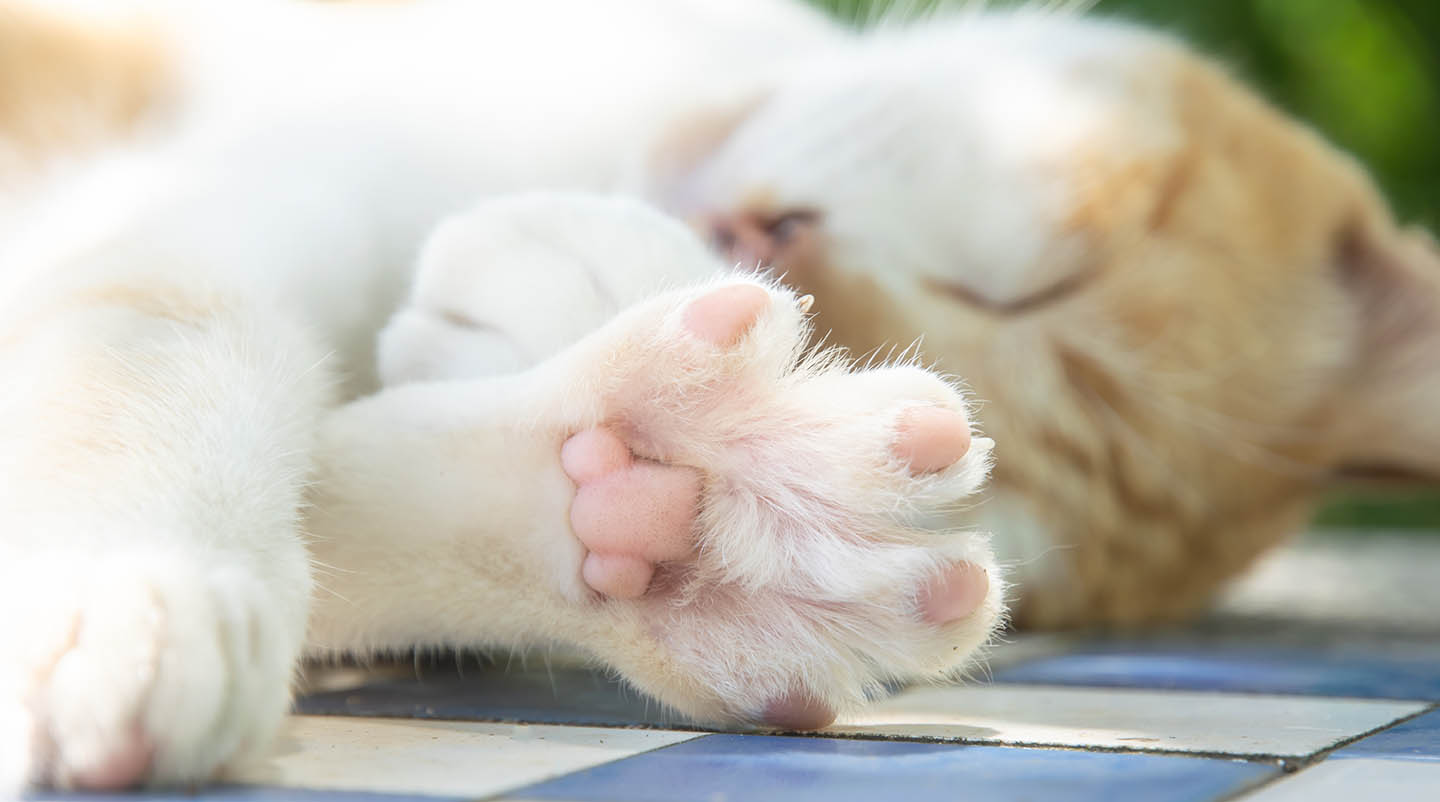
Welcome to our regular “Ask the Cat Doc With Dr. Lynn Bahr” segment! Once a month, Dr. Bahr answers as many of your questions as she can, and you can leave new questions for her in a comment.
Dr. Bahr graduated from the University of Georgia College of Veterinary Medicine in 1991. Unlike most veterinarians, she did not grow up knowing that she would become a veterinarian. “It was a cat who got me interested in the practice and I am forever grateful to him,” said Dr. Bahr. Over the course of her veterinary career, Dr. Bahr found that the lifestyle of cats has changed dramatically. As the lifestyle of cats has changed, so did Dr. Bahr’s client education. In addition to finding medical solutions, she also encourages owners to enrich their home environments so that their cats can live long, happy, and healthy lives.
This new understanding led Dr. Bahr to combine her passion for strengthening the human-animal bond with her veterinary background and knowledge of what animals need and want to start her own solution-based cat product company, Dezi & Roo, inspired by two cats of the same names.
For more information about Dezi & Roo and their unique and innovative cat toys, please visit Dezi and Roo on Etsy.
Do you have a question for Dr. Bahr?
Leave it in a comment and she’ll answer it in next month’s column!

Cat disliked being picked up or held
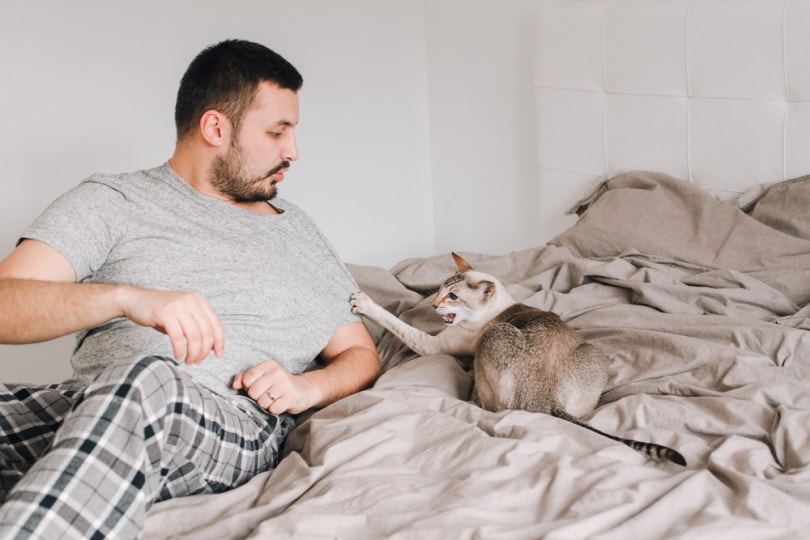
Our 2 yr Highlander (long-haired) unneutered male cat, dislikes being held or picked up. He received hours of attention and petting as a kitten. Now, we need to wear protective gloves to pick him up long enough to place him in a cat carrier. Our vet gave us Gabapentin, yet he will run away when I attempt to approach him. We have two other Highlanders males who are very affectionate. The Feliway and catnip do not help calm his aggressiveness towards being handled. Our vet must give him a sedative to do an exam or grooming. He will use all his strength to get out of my hands even if I hold him with a towel or behind the neck. He is a 100 percent indoor cat. I need to get him neutered this year. Is there anything that I can place in his food or treats that would calm him down to place in the cat carrier? – Millicent P Hollins
Hi Millicent,
Thank you for writing in with this important question.
Many cats, like yours, do not enjoy being picked up or held and often react in the same way as yours. Domestic cats are unique in that they are both predator, and, because of their small size, prey. So, for a feline there’s a great deal of security in having full control over their limbs and being able to run, jump, or hide at will. While queens may scruff and relocate their young for protection, the only other time cats may be picked up is when they encounter a predator such as a coyote or bird of prey. So, it is only natural for a cat to be stressed or frightened when they suddenly lose contact with the ground. For many, such an interaction may be interpreted as an attack.
Being fearful of being picked up may also be a learned behavior. Cats may associate such interactions with negative experiences, such as a car trip to the vet, being restrained while having their nails trimmed, or receiving vaccinations. This may be the root cause of your boy’s fear, stress, and anxiety.
There is also the fact that this kind of snuggly interaction simply isn’t a normal among felines. They show affection among their own species by head bunting, rubbing against one another, mutual grooming, or cuddling together. However, felines don’t pick each other up.
So what can you do to make future vet visits easier? I have a few suggestions.
- If your cat is comfortable with petting, but is hesitant to be picked up, you can start by simply placing your hand on your cat’s side and immediately releasing, and gradually work you way up to placing hands on both of your cat’s sides. Do this several times before attempting to pick him up and be sure to praise and reward him with a favorite toy or delicious treat. The first few times you pick your cat up, keep it very brief. Pick him up and promptly put him back down. With consistent practice – and lots of positive reinforcement – some cats may get accustomed to being held for short periods of time.
- Begin clicker training sessions that include teaching your kitty to easily enter his carrier. You can extend training to teach your cat other actions like riding in the car, accepting a halter, and stationing on a mat. Alternatively, you can get your cat accustomed to his carrier by leaving it out all the time and consistently throwing treats inside to get him comfortable going into it. Make it a daily routine that is fun and rewarding. Then add to the routine by teaching your cat to accept rides in the car. Training will strengthen the bond between you and your boy and you will both be happier for it.
- Administer the gabapentin in a high value food treat the night before and the morning of your veterinary appointment. As a powder, it can be sprinkled on or mixed in with a variety of foods or treats that your cat will enjoy. Some of my favorites are plain yogurt, churu treat, tuna juice, and liverwurst. Or it can be compounded into a flavorful liquid.
- Choose a feline-only veterinarian that is also Fear Free certified. This will go a long way in helping alleviate your cat’s fear and anxiety by ensuring that the experience is as stress-free as possible. Failing to identify and treat your cat’s fear properly, will only make it worse in the future. For example, if you are petrified of spiders, being forced to stay in a room full of them is going make your anxiety worse and escalate your fear rather than eliminate it. Working with a professional that understands your cat’s phobia is the best way to address it properly in the future.
Hopefully, you will find some of these suggestions helpful. Let me know if any work for you.

Male cat pees on bathroom rug
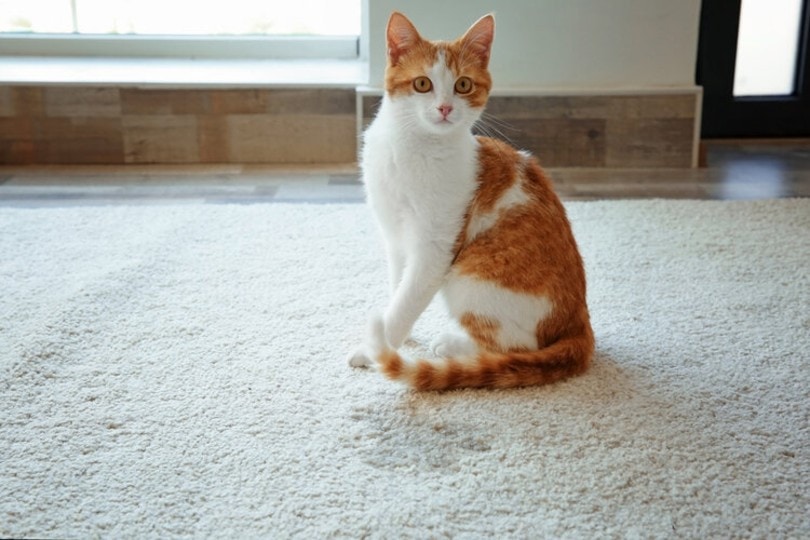
My male cat, nearly 2 years old, routinely pees on any cloth rug in the bathroom. Thankfully, he only does that in the bathroom where his litter box is located. How can I get him to stop? I’d love to be able to have a bath mat or throw rug over the cold tiles! – Phyllis Edwards
Hi Phyllis,
While your question regarding cats that urinate or defecate outside their litter box is a common one, the answers vary according to each individual situation. To determine why your cat is choosing the rug over his litter box I would need a lot more information to help you with this unwanted situation.
There are so many different and possible reasons for your cat’s choice of litter box habits and I am sure your cat would have a good explanation if he were able to tell you. Things I would be interested in knowing include how long this has been going on, when did it start, does your cat ever use the litter box to urinate or does he exclusively use the rug, how often do you clean the litter box, how many boxes do you have, what litter are you using, are there other cats in your household, etc. Looking at an extensive history, along with a complete exam, is how I go about diagnosing the “why” for problems like yours so that we can, together, formulate an appropriate treatment plan.
Your inquiry gives me an opportunity to pivot and discuss a condition that may be helpful to you, and others, and one that is near and dear to my heart, urethral obstructions. I discuss this serious problem with every client as part of my routine “kitten talks” because I want every pet parent to be aware of it in hopes of saving lives. While it does not occur exclusively in young males, they fall into a higher risk category so it would be a good idea for you to familiarize yourself with all aspects of this life-threatening emergency since your boy is a part of that group.
I apologize for not being able to answer your question specifically, but I bet your veterinarian can help. If you haven’t had him seen for this problem, I would encourage you to do. A good history, physical exam, and urinalysis will be needed in order for your veterinarian to help you resolve this problem. Good luck and let me know the outcome.

Cat howls when carrying spring toy
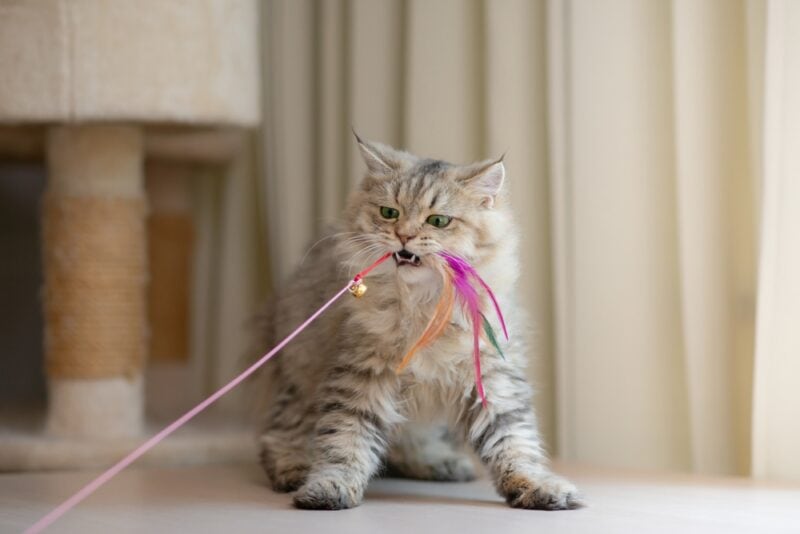
Hi, We have these little cat toys that look like springs, that our cats love. One of our cats, Sparky, will take a spring in his mouth and then walk around howling extremely loud, and then take the spring and place it in his bowl of food before eating the food. I’m always taking out 3 or 4 springs from the dish everyday !! Why do you think he would do this? – Diana
Hi Diana,
It is interesting that so many cats, like yours, engage in this behavior and that it is a frequent question owners ask. I am sure it makes purr-fect sense to our kitties to drop toys in their bowls, but like you, the rest of us are baffled by it. Being human, we can only guess as to why our cats would choose to do this.
Several theories suggest that 1) your cat is teaching you to hunt 2) your cat is hiding its prey 3) your cat is a collector 4) it is doing so because it is fun.
I believe it is instinctual and that cats like Sparky are hunting their prey toys then bringing them to their food or water bowl to be eaten. This type of behavior helps cats in the wild consume prey in solitude and away from competition.
Since Sparky is exhibiting hunting behavior with his spring toys, I would continue to encourage him to do so. It is a good form of enrichment and he obviously enjoys it. Reward him with praise and treats and relish the idea that your cat is active, engaged, and happy. Kudos to you for finding the right prey toy that taps into his desires. You rock!

Food allergies
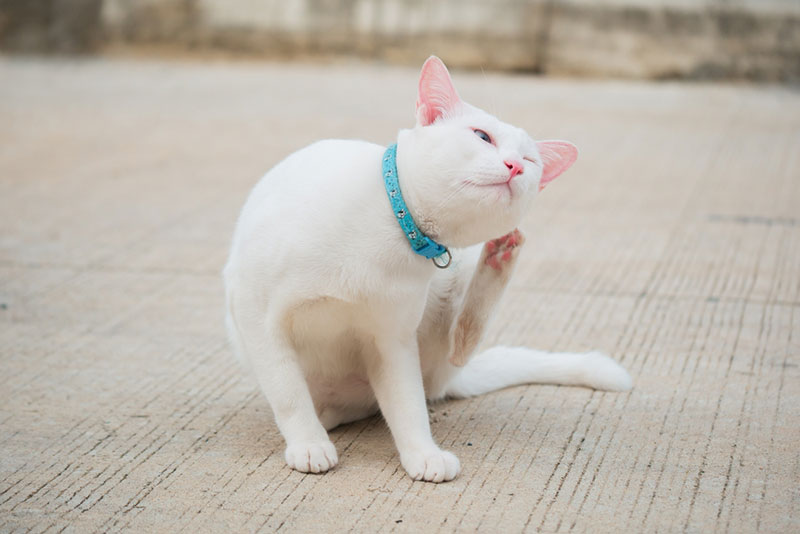
Regarding allergies, I have a couple questions:
1) If a cat is allergic to fish, could they also be allergic to shellfish (e.g. shrimp, crab) or fish oil?
2) If a cat is allergic to chicken, could they also be allergic to other types of birds (e.g. duck, turkey, pheasant or quail)? – Abby
Hi Abby,
Our knowledge of food allergies in cats continues to expand but we have only just begun to scratch the surface of understanding this complex condition. There is so much more to learn and information or recommendations continue to change frequently.
In humans, having one food allergy can put you at higher risk for reaction to other foods so this could certainly be true in other species as well. If your cat does not tolerate chicken or fish, then any poultry or seafood would be best avoided if possible.
The only way to accurately diagnose a food allergy is with a strict diet trial. When carefully executed and in conjunction with your veterinarian, it is possible to challenge a successful diet to add additional food choices in to give your cat variety if this is of interest to you. But before you try anything on your own, I would recommend you seek the advice and guidance from a qualified veterinarian or even better, a veterinary dermatologist.
Thank you for writing in and following this column. I appreciate it.

Skin problems
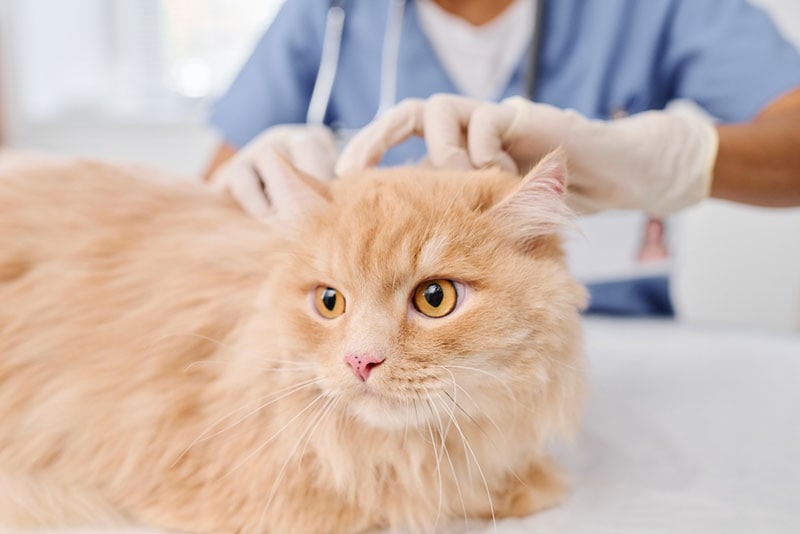
Not sure if I should ask about cat skin/fur problem here. My cat Coco (13 years old) has been having skin problem since many years. We brought him to the vet for ‘i-don’t-know-how-many-times’ for the same issue. He scratches himself very bad, very often I saw blood on his face around eyes and ears. Sometimes tails, and paws. The vet used a blue lamp to check whether he had a fungus, but didn’t see any. Before I fed him wet food(no grain) and since he usually got chicken, so I suspected that he has an allergy against chicken and changed to beef, rabbit, and duck…but didn’t really help. SO I have changed his food and fed him raw beef and salmon…but haven’t seen the improvement yet…Poor thing has to wear a collar and I feel so guilty about that…any idea why? – angiesrecipes
Hi Angie,
I am so sorry to hear that your cat is suffering from skin issues and hope the problem is resolved so that he can be relieved of his collar soon. While Elizabethan collars help keep animals from making their skin issues worse, they are not effective at treating the underlying problem.
So, the best solution would be to diagnose the condition first, then treat accordingly. Since your veterinarian has been unable to do so, I would recommend you seek a second opinion from a feline-only veterinarian, or better yet, a veterinary dermatologist.
The blue lamp you referred to is an old diagnostic tool with minimal value in diagnosing ringworm. While it is important to rule out ringworm as the cause of your cat’s itchy skin, I believe your kitty would benefit from a more extensive work-up. There is a myriad of other conditions that could cause your cat to scratch extensively, and he would benefit greatly from additional diagnostics.
Food allergies can cause pruritis (itching) too, but as I mentioned above, so can a lot of other conditions. Therefore, I would not jump to that conclusion until I ruled-out many of the other common conditions that cause cats to scratch. Therefore, I am encouraging you to take Coco to a veterinary dermatologist or veterinarian well versed in feline skin issues so that he can ditch the collar. Good luck.


